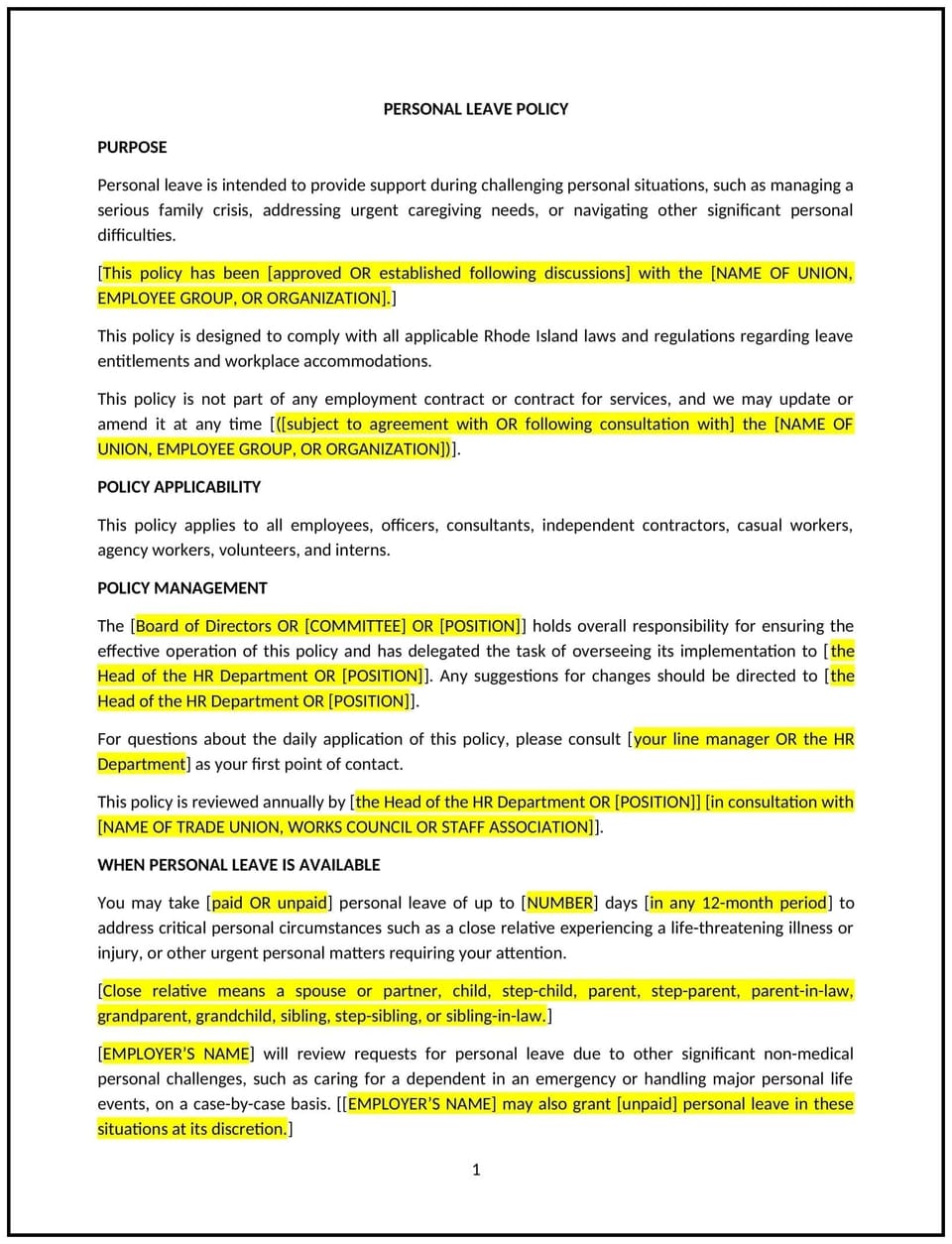Personal leave policy (Rhode Island): Free template

Personal leave policy (Rhode Island)
This personal leave policy is designed to help Rhode Island businesses establish guidelines for employees requesting time off for personal reasons. It outlines procedures for requesting leave, approval processes, and job protection during absences.
By adopting this policy, businesses can support employees during personal challenges, maintain productivity, and ensure fairness in leave management.
How to use this personal leave policy (Rhode Island)
- Define scope: Clarify which types of personal leave are covered, such as medical appointments, family emergencies, or personal days.
- Establish request procedures: Outline steps for employees to request personal leave, including required notice and documentation.
- Set approval process: Specify who must approve personal leave requests and the criteria for approval.
- Address job protection: Guarantee that employees will return to the same or an equivalent position after personal leave.
- Communicate expectations: Share the policy with employees and include it in the employee handbook.
- Train managers: Educate supervisors on handling personal leave requests and maintaining workflow during absences.
- Review and update: Assess the policy annually to ensure it aligns with evolving business needs and legal standards.
Benefits of using this personal leave policy (Rhode Island)
This policy offers several advantages for Rhode Island businesses:
- Supports employees: Demonstrates a commitment to helping employees balance work and personal responsibilities.
- Maintains productivity: Reduces disruptions by providing clear guidelines for managing personal leave.
- Enhances morale: Shows employees that their personal needs are valued, improving loyalty and satisfaction.
- Reduces turnover: Helps retain employees by providing support during personal challenges.
- Builds trust: Fosters a positive workplace culture by prioritizing employee well-being.
Tips for using this personal leave policy (Rhode Island)
- Communicate the policy: Share the policy with employees and include it in the employee handbook.
- Provide training: Educate managers on handling personal leave requests and maintaining workflow during absences.
- Monitor compliance: Regularly review leave requests to ensure adherence to the policy.
- Address issues promptly: Take corrective action if leave requests are mishandled or denied improperly.
- Update regularly: Assess the policy annually to ensure it aligns with evolving business needs and legal standards.
Q: How does this policy benefit businesses?
A: By providing clear guidelines for personal leave, businesses can support employees, maintain productivity, and enhance morale.
Q: What types of personal leave are typically covered under this policy?
A: The policy covers leave for medical appointments, family emergencies, personal days, and other non-work-related needs.
Q: How can businesses manage workflow during employee absences for personal leave?
A: Plan ahead by cross-training employees and adjusting workloads to accommodate absences.
Q: What should businesses do if an employee’s personal leave conflicts with business needs?
A: Work with the employee to find a mutually agreeable solution, but avoid penalizing the employee for taking leave.
Q: How often should businesses review this policy?
A: Businesses should review the policy annually or as needed to ensure it aligns with evolving business needs and legal standards.
This article contains general legal information and does not contain legal advice. Cobrief is not a law firm or a substitute for an attorney or law firm. The law is complex and changes often. For legal advice, please ask a lawyer.


